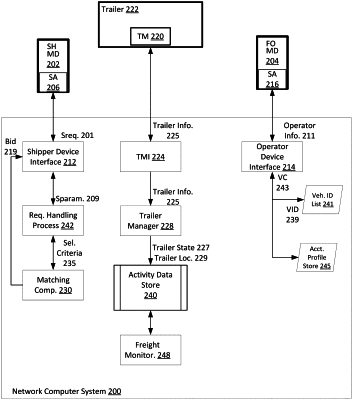| CPC G06Q 10/0833 (2013.01) [G06Q 10/0834 (2013.01); G01S 19/13 (2013.01)] | 20 Claims |

|
1. A computing system comprising:
one or more processors; and
one or more non-transitory, computer-readable media storing instructions that are executable by the one or more processors to cause the computing system to perform operations, the operations comprising:
receiving a freight request, the freight request specifying a pickup location and a destination location for a load;
associating the load with a trailer module associated with a trailer;
assigning a selected freight operator to transport the load to the destination location associated with the freight request;
monitoring a trailer module location based on accessing data from location determining hardware of the trailer module;
monitoring a freight operator location based on accessing data from location determining hardware of the trailer module;
automatically detecting, based on the trailer module location and freight operator location, that the freight operator is hauling the trailer based at least in part on monitoring the trailer module location and the freight operator location; and
transmitting instructions which cause the trailer module to operate in a sleep lode based on detecting that the freight operator is hauling the trailer.
|